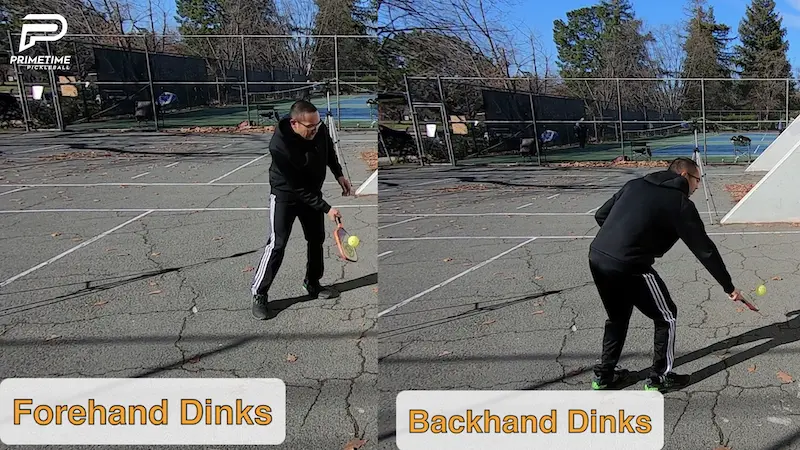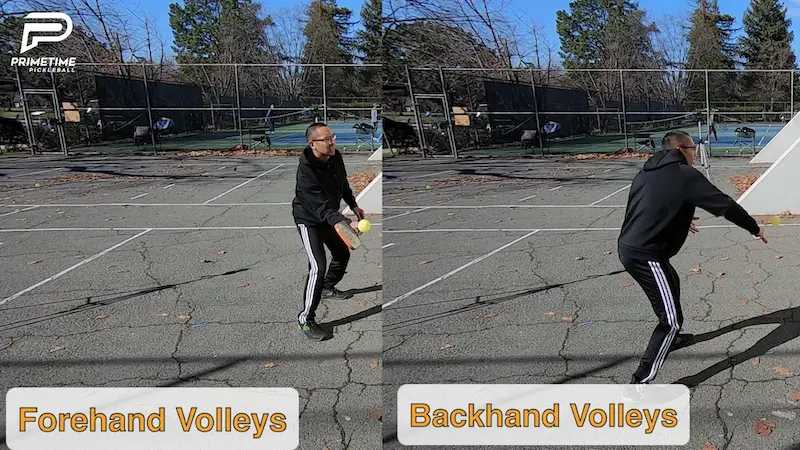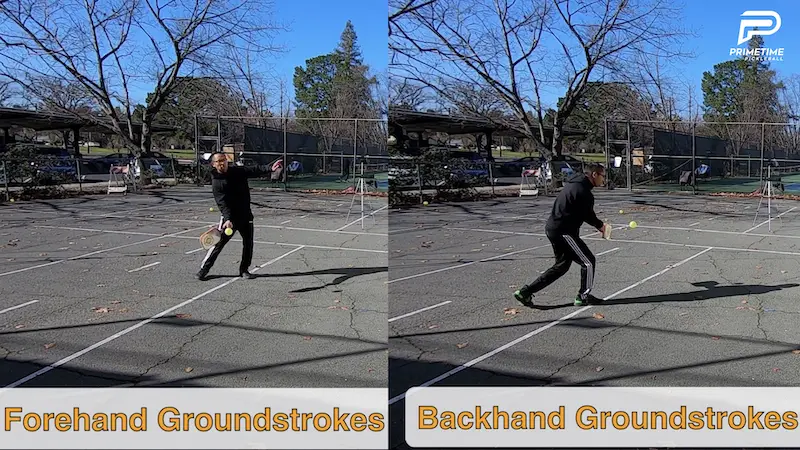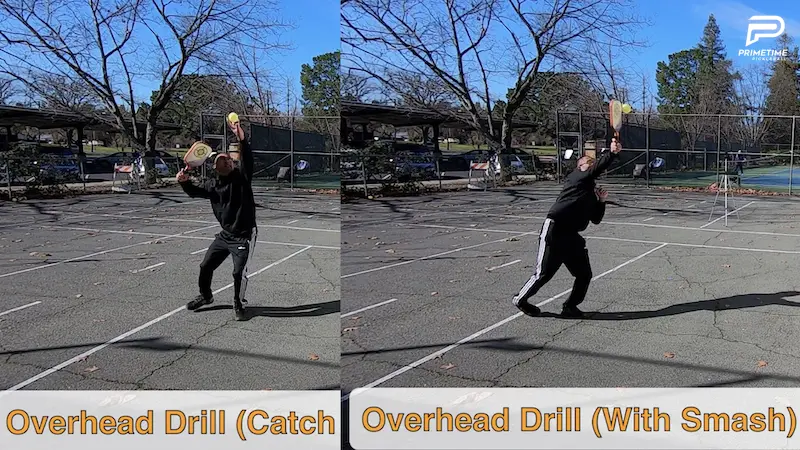In today’s blog we’re going to discuss the top pickleball wall drills.
You can go to a public community wall which should be a multi-purpose wall.
We’ll go over five different categories: dinks, volleys, resets, ground strokes, and overheads.
The first drill that we’re going to talk about has to do with dinking.
You really want to focus on getting a consistent contact point out in front of you and you’re going to try to do your best to watch the ball.
*Quick disclaimer – if you’re practicing on a court with a lot of cracks and the ball lands on the crack, just let it roll and then start over.*
You’ll notice that because of the asphalt that the bounce is not true and it’s a little bit different every time. However, just try to do your best and concentrate on what you can which is a consistent contact point out in front and keeping your eye on the ball. You’ll also want to get low with your legs which is very important.
You’ll practice on the forehand side first and then the backhand side. Afterwards you will alternate by going from your forehand to backhand and try to your best to switch every time. This will also help work on your footwork.

Next, we’re going to jump in to some volley drills. We get a lot of volleys in the game of pickleball.
The first thing you want to start off with is regular forehand volleys.
While focusing on your contact point you should also be trying to keep a focal point on the wall since these volleys are going to be fast and you’re not going to be able to watch and keep up with the ball the whole time. You want to keep an area that you’re looking straight ahead at. a
Remember that you should be hitting these forehand volleys with a continental grip.
You should be going nice and low, trying to keep your contact out in front as best you can. Your eyes should generally be fixed in a certain place on the wall.
Next you’re going to move to the backhand side and do the same thing. Try to hit the sweet spot of your paddle every time.

The next part of the drill is a little bit tougher. You’re going to alternate from forehand to backhand. This is going to work on your directional control.
You may need to move and shift your feet a little bit to get in a good position.
The last volley drill that we’re going to show you is called the two touch drill. It’s an advanced skill and an advanced drill. Go out there and try it. Hopefully you can work up to it.
When you do the drill you should still keep trying to keep your contact point out in front, bouncing the ball off your paddle first and then sending it to the wall. This takes a lot of paddle control.
Do the drill on your forehand side first and then switch to your backhand side. The backhand side is a lot tougher. Try your best to get the ball under control.
The next part of the drill has to do with ground strokes.
This is a good thing that you can practice against a wall.
You want to drop feed the ball and keep hitting ground strokes one repetition after the next.
It may be tough because all the cracks (if applicable to your situation) so what you can do is feed a short high ball off the wall and then act like you’re hitting a third shot drive.
You’re going to start on your forehand side as per usual.
A few things that you should focus on is getting your feet in correct position. Also, you should be hitting with a closed stance and also keeping that contact out in front.
Try to focus on a nice smooth relaxed swing.
If the ball doesn’t bounce right then just catch it and feed it again.
You should be trying to aim right above your imaginary net target (or if there is a net line drawn on the wall) as you’re hitting a third shot drive while working on your ground strokes.
After you’re done practicing your forehand, do the same thing on the backhand side.

Next part of the drill will be working on resets.
For the first reset drill you’re just going to feed the ball off the wall with good pace and then you’re going to work on your reset. Start on the forehand side.
You want to feed the ball hard off the wall then try to slow it down with a reset.
You’re going to be focusing on your contact point out in front, having a loose grip, trying to drop that ball into the kitchen.
Then you can do the same thing on the backhand side.
Again, focus on keeping that ball out in front and with the resets it’s really important, when you’re trying to hit the shot, remember you’re trying to hit the first ball with a lot of pace so that you can then slow it down.
The second reset drill is a little variation. You’re going to feed the ball high off the wall, hit a drive and then after your drive you’re going to try to reset it.
You should be hitting your drive with your momentum coming in and then stopping and hitting that reset into the kitchen.
Start with the forehand and then do the same thing on your backhand side.
The last drill you’re going to do has to do with overheads.
For the first variation you’re not going to hit the ball, you’re just going to practice your footwork for your overheads.
Then the second variation you’re going to hit the ball. You’re going to start approximately 10 feet behind the wall and then you’re going to hit the ball high off the wall.
What you’re going to do for correct overhead footwork is to make sure you turn sideways and make sure your shoulders are perpendicular to the wall.
You’ll catch the ball up high above your head where you want to make contact with the ball.
Start by feeding the ball off the wall and then catching it way up above your head in front of you. Your paddle, in the other hand, will also be above you but slightly behind your head.
You could start off with shallow feeds so you don’t have to go too far back. Once you work on that footwork and get comfortable with it you can then make it a little bit more challenging and practice those really deep lobs by feeding it harder off the wall.
This is a really good drill, it really works on your footwork.
Next, you’ll do the same thing but instead of catching the ball you’ll put your hand up so you can track the ball and as it comes down you’re going to swing and aim for the wall.

Remember the key things you want to focus on is good footwork, making sure you get sideways so that you can shuffle back when you need to go for a deep lob, making sure you keep you hand up over you head to track the ball while having your paddle in the other hand up and behind your head. and making sure you are striking the ball out of front.
That concludes our top pickleball wall drills. Hopefully these are very helpful to you.
If you can’t play right now or you don’t have partners to play with, this is a good thing that you can do.
You can always improve your game using a wall.